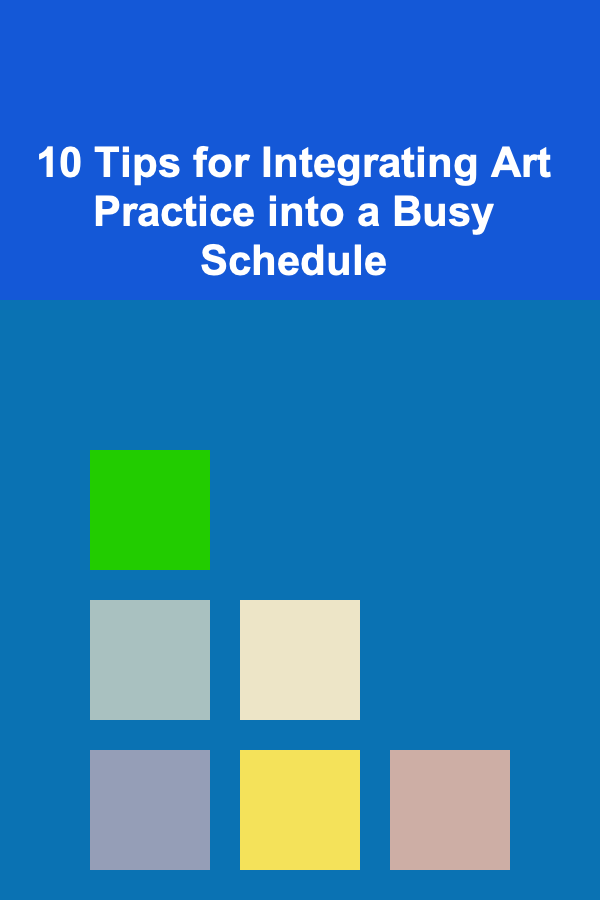
10 Tips for Integrating Art Practice into a Busy Schedule
ebook include PDF & Audio bundle (Micro Guide)
$12.99$5.99
Limited Time Offer! Order within the next:

In our fast-paced world, finding time to pursue creative endeavors like art can be challenging. Between work, family obligations, social commitments, and personal responsibilities, carving out moments to practice art often feels like a luxury. However, art is an essential form of expression and a source of personal fulfillment. It allows individuals to connect with their emotions, relieve stress, and develop a deeper understanding of the world around them.
The good news is that with a bit of creativity and planning, it is possible to integrate art practice into even the busiest of schedules. Below, we outline 10 practical tips that can help you find time to practice art, no matter how hectic your life may be.
Set Clear, Achievable Goals
One of the first steps to integrating art into your busy life is setting clear, achievable goals. These goals should be both specific and realistic, considering the time you have available. Rather than aiming to complete a large-scale project in one sitting, break it down into smaller, manageable tasks.
How to Set Goals:
- Daily Goals: For example, aim to sketch for 10 minutes every day. While this may seem minimal, over time, it will add up and keep you in a creative flow.
- Weekly Goals: Choose a larger task, like completing a painting or trying a new medium, and allocate specific time slots during the week to work on it.
- Monthly Goals: Reflect on your progress and set a more ambitious goal for the upcoming month, such as finishing a complete series or mastering a specific technique.
By setting achievable goals, you can ensure consistent progress without overwhelming yourself. Remember, art is a journey, not a race.
Prioritize Time for Art
Often, the reason art gets pushed aside is because it's not viewed as a priority. If you're serious about making time for it, you need to shift your mindset and treat art as a priority, just like work, exercise, or socializing.
How to Prioritize:
- Block Time on Your Calendar: Whether it's an hour every morning or a few evenings a week, block out time for art just like you would for a meeting or exercise.
- Commit to Consistency: Even if it's just 15 minutes a day, commit to practicing regularly. Consistency is key to maintaining momentum.
- Schedule Around Other Activities: Look for gaps in your schedule that can be filled with art practice. Perhaps you can sketch during your lunch break or paint after the kids go to bed.
By treating your art practice as a priority, you'll find that you're more likely to stick to it, even on the busiest of days.
Create a Dedicated Art Space
Having a dedicated space for your art can help minimize the time spent on setup and cleanup. Whether it's a small corner of your living room or a full-fledged studio, having a designated area allows you to easily transition into your creative process.
How to Set Up Your Space:
- Keep Materials Handy: Store your art supplies in a way that makes them easy to access. This will make it simpler to jump into your practice without a lot of prep time.
- Create an Inspiring Environment: Surround yourself with objects or artwork that inspire you. This could include photos, plants, or pieces of your past work.
- Keep It Minimal: You don't need a huge space to create art. Even a small desk with enough room for a sketchbook and a few supplies can be all you need.
A dedicated art space not only saves time but also helps you get into the right mindset for creating.
Use Spare Moments Wisely
Life is full of small, seemingly insignificant moments that can add up to a substantial amount of time. Rather than letting these moments slip away, use them to your advantage by engaging in your art practice during brief breaks.
How to Use Spare Moments:
- Carry a Sketchbook: Keep a small sketchbook in your bag or car, so you can sketch during moments of downtime, whether you're waiting for a bus or sitting in a doctor's office.
- Take Quick Photos: Use your phone's camera to capture interesting textures, colors, or compositions that can inspire your artwork later.
- Practice Drawing from Observation: Take a few minutes during lunch to draw something around you, such as a scene outside your window or objects on your desk.
These brief moments can help you stay engaged with your art without demanding a significant amount of time.
Combine Art with Other Activities
One of the best ways to make time for art is to combine it with other activities you're already doing. By integrating art into existing routines, you can minimize the need to carve out additional time in your schedule.
How to Combine Art with Other Activities:
- Listen to Art Podcasts or Audiobooks: While commuting or exercising, listen to podcasts about art techniques, artist interviews, or art history.
- Draw While Watching TV: Set up a drawing pad in front of the TV and doodle while watching your favorite shows.
- Incorporate Art into Social Time: Host an art night with friends or family, where everyone works on a creative project together.
By blending art with other activities, you can stay connected to your creative side without sacrificing time for other important aspects of your life.
Set Realistic Expectations
It's easy to feel discouraged if you have grand artistic ambitions but limited time. To avoid burnout, set realistic expectations for what you can achieve in a given timeframe.
How to Set Expectations:
- Focus on Small Wins: Instead of aiming for a finished masterpiece, focus on making incremental progress, such as completing a sketch, experimenting with a new medium, or learning a new technique.
- Understand Your Limits: Be kind to yourself and acknowledge that some weeks may be busier than others. On those weeks, it's okay to spend just a few minutes on your art or even take a break from it entirely.
By setting realistic expectations, you'll be less likely to feel frustrated or discouraged when things don't go as planned.
Use Digital Tools to Stay Organized
In today's digital world, there are many tools that can help you stay organized and motivated in your art practice. Whether you're tracking your progress or looking for inspiration, digital tools can streamline your process.
Helpful Digital Tools:
- Art Apps: Apps like Procreate or Adobe Fresco allow you to create digital art on the go, offering flexibility when you don't have access to traditional art supplies.
- Online Art Communities: Join online communities like Instagram, DeviantArt, or Behance to share your work, get feedback, and stay inspired.
- Task Management Apps: Use apps like Todoist or Trello to create art-related to-do lists, helping you stay organized and focused on your goals.
Digital tools can help you keep track of your progress, find new ideas, and stay engaged in your practice, even when you're on the go.
Use Art as a Form of Self-Care
Incorporating art into your busy schedule can also serve as a form of self-care. The process of creating can be therapeutic and meditative, offering a break from the demands of daily life. Treating art as a self-care activity can make it easier to prioritize and integrate into your routine.
How Art Can Be Self-Care:
- Relaxation: Art can help you relax and unwind after a stressful day. Drawing, painting, or crafting can serve as a form of mindfulness, helping you focus on the present moment.
- Emotional Expression: Art allows you to express emotions that may be difficult to verbalize. Whether you're feeling joy, sadness, or frustration, creating art can provide an outlet for these feelings.
- Sense of Accomplishment: Completing an art project, no matter how small, can provide a sense of accomplishment and boost your self-esteem.
By viewing art as a form of self-care, you're more likely to make time for it, knowing that it's beneficial for your mental and emotional well-being.
Set Boundaries and Eliminate Distractions
If you want to dedicate time to art, it's crucial to set boundaries and eliminate distractions during your practice sessions. This means turning off notifications, setting aside time for focused work, and being mindful of how your time is spent.
How to Eliminate Distractions:
- Turn off Your Phone: If you're working on a piece, silence your phone or use apps that block notifications to minimize distractions.
- Create a Focused Environment: Whether it's a quiet room or a noise-canceling headset, find a space where you can work without interruptions.
- Communicate Your Intentions: Let your family, friends, or coworkers know that you've set aside time for art and would appreciate not being interrupted.
By eliminating distractions, you'll be able to make the most of the time you've set aside for art, ensuring that your creative practice is more productive and fulfilling.
Embrace Flexibility and Adaptability
Life is unpredictable, and there will be times when your schedule doesn't allow for uninterrupted art sessions. During these moments, it's essential to embrace flexibility and adapt your art practice to fit your current situation.
How to Be Flexible:
- Work in Short Bursts: If you can't dedicate an hour to art, work for 15 minutes instead. Sometimes, even short bursts of creativity can be incredibly rewarding.
- Embrace Imperfection: Don't worry if your art doesn't always turn out as planned. Embrace the process rather than focusing on the end result.
- Adapt to Your Environment: If you can't access your usual art supplies, try working with what's available to you. Use a pen and notebook if that's all you have at the moment.
By embracing flexibility, you'll prevent frustration and stay engaged in your practice, even when things don't go as planned.
Conclusion
Integrating art into a busy schedule is entirely possible with the right mindset and strategies. By setting clear goals, prioritizing your time, creating a dedicated space, and embracing flexibility, you can make art a regular part of your life. Art is not only a creative outlet but also a source of joy, self-expression, and personal growth. With a little effort and organization, you can enjoy the benefits of art practice, no matter how busy your life may be.
Reading More From Our Other Websites
- [Home Renovating 101] How to Choose Lighting Fixtures That Enhance Your Space
- [Organization Tip 101] How to Set Up a Plant Care Station in Your Hobby Room
- [Home Renovating 101] How to Renovate Your Home for Better Indoor Air Quality
- [Personal Investment 101] How to Successfully Implement House Hacking to Accelerate Your Real Estate Investing Journey
- [Gardening 101] Designing a Butterfly Garden: Tips for Every Season
- [Tiny Home Living Tip 101] Best Multi‑Functional Furniture Ideas to Maximize Tiny Home Space
- [Home Staging 101] How to Stage Your Home to Appeal to Eco-Conscious Buyers
- [Home Space Saving 101] How to Maximize Bathroom Space with Clever Storage Solutions
- [Home Holiday Decoration 101] How to Repurpose Everyday Items for Holiday Decorations
- [Survival Kit 101] Why You Should Consider a Pre-Built Survival Kit for Your Emergency Plan

How to Keep Track of Utility Bills and Expenses for Rentals
Read More
How to Make a Checklist for Cybersecurity and Data Protection in an Emergency
Read More
How to Maximize Your Investment Returns with a Rebalancing Strategy
Read More
How to Stage a Small Home to Make It Appear Larger
Read More
How to Use Tax Preparation to Make Money
Read More
How to Learn Advanced Excel for Data Analysis
Read MoreOther Products

How to Keep Track of Utility Bills and Expenses for Rentals
Read More
How to Make a Checklist for Cybersecurity and Data Protection in an Emergency
Read More
How to Maximize Your Investment Returns with a Rebalancing Strategy
Read More
How to Stage a Small Home to Make It Appear Larger
Read More
How to Use Tax Preparation to Make Money
Read More